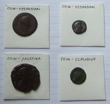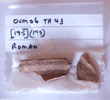
The Romans in the North West
Professor David Shotter and his wife kindly visited us in 2007 and offered some interesting insights into how archaeological discoveries in the North West over last quarter of century are helping to re-write the history books:
Goods
Finds from places like Silchester and Stanwick are revealing evidence the�the Northern Iron Age tribes already had a network of trade and political contacts with Rome at least 50 years before the Romans actually arrived in AD 43.
Finds from places like Silchester and Stanwick are revealing evidence the�the Northern Iron Age tribes already had a network of trade and political contacts with Rome at least 50 years before the Romans actually arrived in AD 43.
Industry
Manufacturing activity discovered in Wilderspool near Warrington, helps to explain how�supplies were obtained locally of all the necessary worked iron, silver, bronze, glass, pottery, bricks and roof tiles required by the Romans.
Manufacturing activity discovered in Wilderspool near Warrington, helps to explain how�supplies were obtained locally of all the necessary worked iron, silver, bronze, glass, pottery, bricks and roof tiles required by the Romans.
Buildings
Discoveries at Chester include�a unique elliptical building which seems to have been decorated by the 12 Olympian deities. Such themes�are designed to be symbolic of Roman power and�would support the idea that the North West had strategic significance�in the campaigns against the Welsh and the Scots, in their two pronged forays into Wales and Scotalnd by land and sea.
Discoveries at Chester include�a unique elliptical building which seems to have been decorated by the 12 Olympian deities. Such themes�are designed to be symbolic of Roman power and�would support the idea that the North West had strategic significance�in the campaigns against the Welsh and the Scots, in their two pronged forays into Wales and Scotalnd by land and sea.
Marginal Land
Is revealing evidence lost elsewhere by development and farming. A campaign camp possibly only used for a season or part of a season has been uncovered at Malham Moor where the earthwork rampart and ditch has not been destroyed by ploughing.
Is revealing evidence lost elsewhere by development and farming. A campaign camp possibly only used for a season or part of a season has been uncovered at Malham Moor where the earthwork rampart and ditch has not been destroyed by ploughing.
Wood
Carlisle�has proved to have areas with extraordinary preservation qualities where anaerobic layers are sealed by layers of gravel. Dendrochronology used on timbers from these layers are giving the first accurate dates of timbers used in the palisade and buildings. Elsewhere, a waterlogged ditch in a Roman camp at Kirkham has preserved a very rare complete example of a waisted javelin which�were now believed to have been tied together and splayed upright, in threes, to provide a temporary defense equivalent to barbed wire.
Carlisle�has proved to have areas with extraordinary preservation qualities where anaerobic layers are sealed by layers of gravel. Dendrochronology used on timbers from these layers are giving the first accurate dates of timbers used in the palisade and buildings. Elsewhere, a waterlogged ditch in a Roman camp at Kirkham has preserved a very rare complete example of a waisted javelin which�were now believed to have been tied together and splayed upright, in threes, to provide a temporary defense equivalent to barbed wire.
Experimental Archaology
A reconstructed wooden fort at Coventry has provided further information as it has aged naturally since it was built and demonstrates that the structure would have had a natural life of about 20 years before it needed significant repair and renovation.
A reconstructed wooden fort at Coventry has provided further information as it has aged naturally since it was built and demonstrates that the structure would have had a natural life of about 20 years before it needed significant repair and renovation.

Coins
Numismatics or the study of coins, provide a wealth of information as coinage was not previously used amongst the Northern British tribes so their very presence points to that of the Roman army, with the denominations of coin even giving some indication of the rank of the soldiers. The coins themselves can be dated, but there may also be further refinements of date, for example in times of poor supply such as during the reign of Claudius when the army was forced to mint its own coins,�these poor copies were quickly withdrawn from circulation again�when supply had improved.�
Numismatics or the study of coins, provide a wealth of information as coinage was not previously used amongst the Northern British tribes so their very presence points to that of the Roman army, with the denominations of coin even giving some indication of the rank of the soldiers. The coins themselves can be dated, but there may also be further refinements of date, for example in times of poor supply such as during the reign of Claudius when the army was forced to mint its own coins,�these poor copies were quickly withdrawn from circulation again�when supply had improved.�


Professor Shotter very kindly examined the four Roman Coins found in and around the site at Mellor and explains what is known about them. A fascinating aspect of this is not only in whose reign�the coins were produced ( giving us a range of possible production dates) but also, using the amount of wear of the surfaces and edges as a guide,�how long they might have been in circulation and when they might have been lost and ended up in the ground.

Read about the Roman Brooches found at Mellor
Read about the Roman Pottery found at Mellor
Find out what tells us about the Romano British Period at Mellor
With thanks to Professor David Shotter
